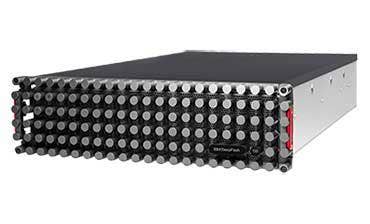IBM Intros DeepFlash 150 All-Flash Storage For Big Data, Other Unstructured Workloads

IBM Tuesday expanded its all-flash storage line with a new offering targeting big data and other unstructured data applications.
The new IBM DeepFlash 150, which is scheduled to start shipping late this week, is aimed at the types of applications that require capabilities not found on standard all-flash storage solutions, said Alex Chen, IBM's director of storage systems and offering executive for file and object storage.
The majority of all-flash storage arrays are focused on more traditional applications such as virtual desktop infrastructure, block storage and on-line transaction processing, Chen told CRN.
[Related: The 10 Coolest Flash Storage And SSD Products Of 2016 (So Far)]
"Analysts tell us 80 percent of data is unstructured," he said. "Big data is a different problem for flash storage. With big data, data is measured in petabytes, not terabytes. And unstructured data is growing twice as quickly as structured data. So scalability is a big factor."
Big data and other unstructured data also require low-cost storage, Chen said. "A lot of unstructured data like videos is already compressed, so it's hard to count on data reduction to save capacity," he said.
For that reason, the IBM DeepFlash 150 is based on a different architecture than IBM's current FlashCore-based all-flash arrays, Chen said.
IBM, Armonk, N.Y., said the new offering has a price of about $1 per GB. Chen did say that many vendors, including IBM, already have all-flash solutions at that price point. "But the others, including the IBM solutions, include compression and deduplication, which don't work with unstructured data," he said.
The IBM DeepFlash 150 is based on a 3U chassis, each of which can be configured with 128 TB to 512 TB of capacity. When combined with IBM's Spectrum Scale software for file, object and integrated data analytics, the IBM DeepFlash 150 can scale to multiple exabytes of capacity, Chen said.
Combining the two as a complete solution will help customers and channel partners with workloads such as in-memory analytics, media and entertainment, real-time analytics, high-performance computing, life sciences and genomics, he said.
It is the ability to create solutions which include Spectrum Scale that make the IBM DeepFlash 150 so interesting to Michael Sedlmayer, president and infrastructure architect at Re-Store, a San Marcos, Calif.-based solution provider and longtime IBM business partner.
To use all-flash storage with big data and other unstructured data, there has to be enough capacity to handle the entire workload at one time, and the ability to move the data elsewhere when finished, Re-Store's Sedlmayer told CRN.
"The barrier to this has been the high cost of flash storage," he said. "If a working set requires 100 TB of capacity, but the customer can only afford 10 TB, it's hard to handle the workload. With the DeepFlash 150, customers can afford to leverage flash into their workloads."
John Zawistowski, global systems solution executive at Sycomp, a Foster City, Calif.-based solution provider and longtime IBM business partner, said the DeepFlash 150 fills a huge void in IBM's flash storage product line.
"IBM's flash storage is the fastest in the market," Zawistowski told CRN. "But it was missing something in the middle ground for applications that don't need the fastest storage. But when coupled with Spectrum Scale, the DeepFlash 150 gets advanced functionality."
Customers don't always need the performance of IBM's FlashCore-based storage, Zawistowski said. "Price is relative to performance," he said.
IBM's Chen said he expects the company's channel partners to account for about 80 percent of sales of the DeepFlash 150, particularly partners with Spectrum Scale performance.
"This year, we expect a good portion of the DeepFlash 150 customers will already have Spectrum Scale connected to older storage who want to increase performance," he said. "That's the easiest adoption in the beginning. But over time, we'll see more use cases with customers using other file systems."